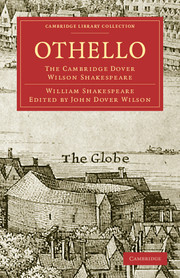THE COPY FOR OTHELLO, 1622 AND 1623
Published online by Cambridge University Press: 07 September 2010
Summary
We have two substantive texts of Othello: the first quarto (Q.) of 1622 and the First Folio text (F.). Q2 (1630), printed from an example of QI which had been edited in the light of F., is a derivative, eclectic text without independent authority.
That F. preserves the better text has never been seriously in doubt, but until recently the relationship between Q. and F. was obscured by the belief that both were set up from manuscript. What their readings, on the contrary, suggest is that Jaggard's copy for F. was an example of Q. which had been hand-corrected by collation with an authoritative manuscript. The editorial position is, therefore, much like that in Richard III: namely, an editor must expect to find that now the one text and now the other preserves the truth and that sometimes, through oversights on the part of the collator or compositor, F. will have reproduced a Q. error.
THE QUARTO, 1622
Q. (1622) was printed by Nicholas Okes for Thomas Walkley, whose copyright was entered in the Stationers' Register on 6 October 1621. The Q. title-leaf is followed by a short preface from ‘The Stationer to the Reader’, which unfortunately gives no information about the provenance of his manuscript:
To set forth a booke without an Epistle, were like to the old English prouerbe, A blew coat without a badge, & the Author being dead, I thought good to take that piece of worke vpon mee: To commend it, I will not, for that which is good, I hope every man will commend, without intreaty: and I am the bolder, because the Authors name is sufficient to vent his worke.
- Type
- Chapter
- Information
- OthelloThe Cambridge Dover Wilson Shakespeare, pp. 121 - 135Publisher: Cambridge University PressPrint publication year: 2009First published in: 1957



